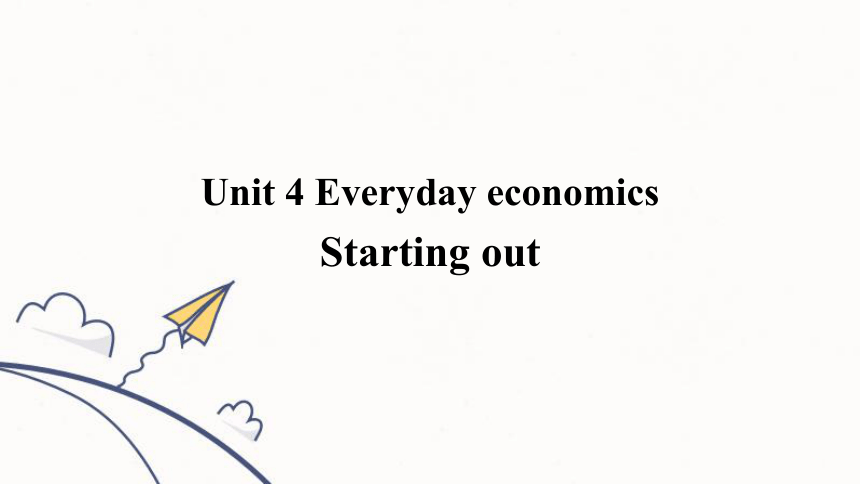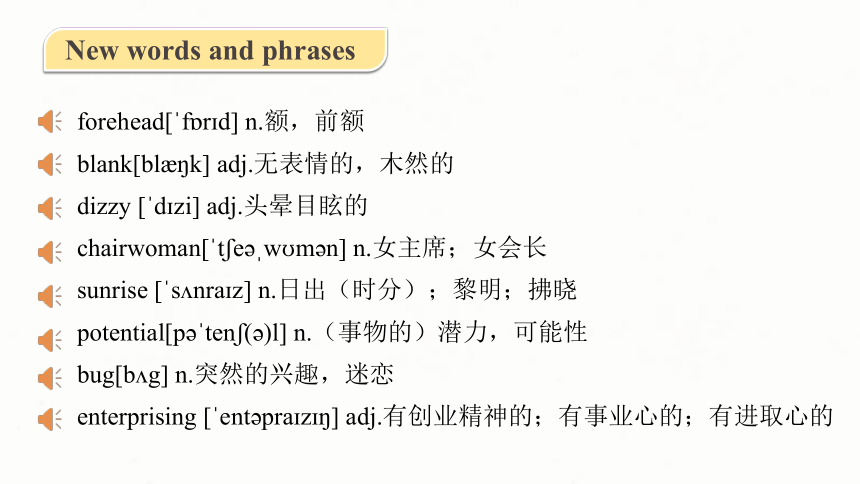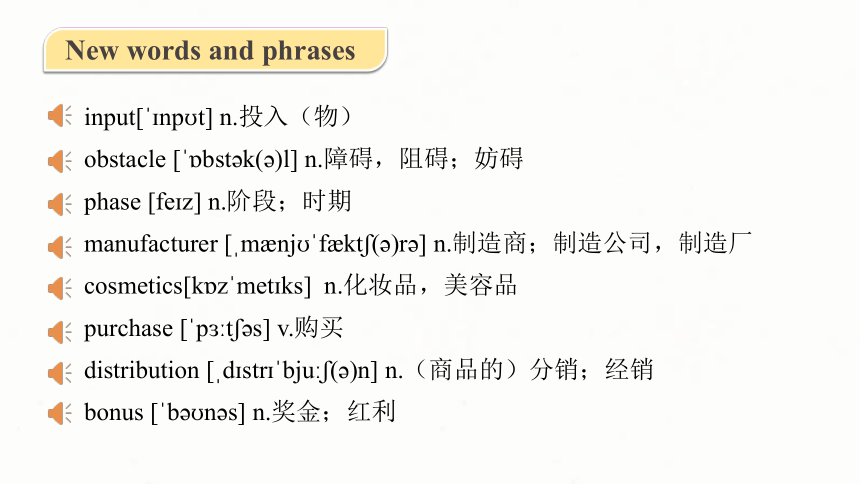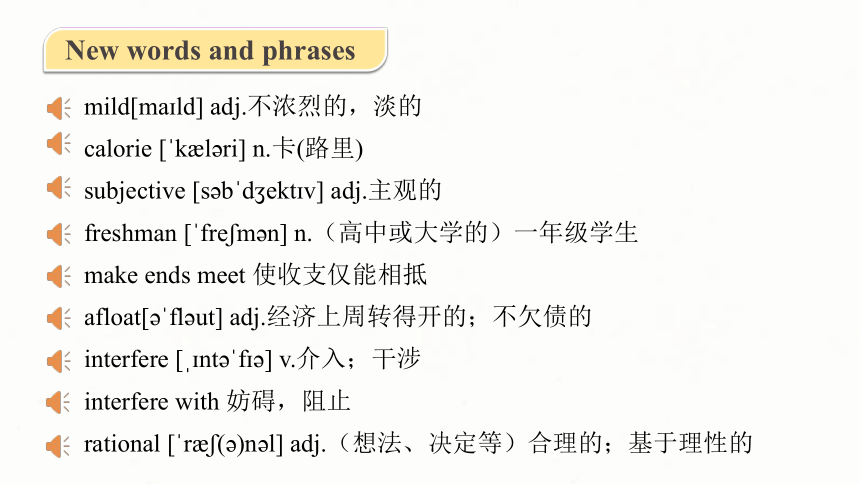Unit 4 Everyday economics Starting out 课件(共21张,内嵌音视频)2024-2025学年高二英语外研版(2019)选择性必修4
文档属性
| 名称 | Unit 4 Everyday economics Starting out 课件(共21张,内嵌音视频)2024-2025学年高二英语外研版(2019)选择性必修4 |  | |
| 格式 | pptx | ||
| 文件大小 | 24.3MB | ||
| 资源类型 | 教案 | ||
| 版本资源 | 外研版(2019) | ||
| 科目 | 英语 | ||
| 更新时间 | 2025-04-23 09:02:27 | ||
图片预览









文档简介
(共21张PPT)
Unit 4 Everyday economics
Starting out
To talk about what you have known about different forms of currency;
To understand daily economic activities by looking at pictures;
To talk about the economic activities around you and your assumption for the future use of money.
Learning objectives
New words and phrases
forehead[ f r d] n.额,前额
blank[bl k] adj.无表情的,木然的
dizzy [ d zi] adj.头晕目眩的
chairwoman[ t e w m n] n.女主席;女会长
sunrise [ s nra z] n.日出(时分);黎明;拂晓
potential[p ten ( )l] n.(事物的)潜力,可能性
bug[b g] n.突然的兴趣,迷恋
enterprising [ ent pra z ] adj.有创业精神的;有事业心的;有进取心的
input[ np t] n.投入(物)
obstacle [ bst k( )l] n.障碍,阻碍;妨碍
phase [fe z] n.阶段;时期
manufacturer [ m nj f kt ( )r ] n.制造商;制造公司,制造厂
cosmetics[k z met ks] n.化妆品,美容品
purchase [ p t s] v.购买
distribution [ d str bju ( )n] n.(商品的)分销;经销
bonus [ b n s] n.奖金;红利
New words and phrases
entrepreneurial[ ntr pr 'n :ri l]adj. 创业的,具有创业精神的
guidance [ ga d( )ns] n.指导,引导
consultant[k n's lt nt] n. 顾问
conventional[k n ven ( )n l] adj.传统的;常规的
discriminate[d skr m ne t] v.不公正地区别对待,歧视
equator[ kwe t ] n.赤道
estate[ ste t] n.庄园
superior [su: p ri ] adj.质量上乘的,优质的
New words and phrases
mild[ma ld] adj.不浓烈的,淡的
calorie [ k l ri] n.卡(路里)
subjective [s b d ekt v] adj.主观的
freshman [ fre m n] n.(高中或大学的)一年级学生
make ends meet 使收支仅能相抵
afloat[ fl ut] adj.经济上周转得开的;不欠债的
interfere [ nt f ] v.介入;干涉
interfere with 妨碍,阻止
rational [ r ( )n l] adj.(想法、决定等)合理的;基于理性的
New words and phrases
exceed[ k si d] v.超过,超出
go into debt 陷入债务之中,负债
financial[f n n ( )l] adj.财政的;金融的;财务的
accumulate[ kju mj le t] v.积累;积聚
automatically[ t m t kli] adv.自动地
toddler [ t dl ] n.学步的儿童;刚学走路的孩子
sorrow [ s r ] n.令人悲伤的事,不幸
frustration[fr stre ( )n] n.懊丧,懊恼,沮丧
hire[ha ] vt.(短期的)租用;租借
New words and phrases
designer clothes 名牌服装
rent out 出租(房屋,房间,土地等)
thereby [ e ba ] adv.因此,由此
supervision [ su p v ( )n] n.监督;管理
expense [ ks pens] n.消费;花费
at the expense of 以损害……为代价
abuse[ bju s] n.滥用
theft[θeft]n.偷窃,偷盗
purse[p s] n.(女式)钱包
New words and phrases
拓展单词
1___________adj.有创业精神的,有进取心的_________n. 企业;事业;进取心;事业心
2.__________n. (商业的)分销,经销;发行___________v.(书报的)发生
3._______ n.指导,引导______v.引导,带领,操纵
4.___________ n. 顾问___________v. 商量,请教,当顾问
5.____________adj.传统的,常规的 _____________n.惯例,习俗
enterprising
enterprise
distribution
distribute
guidance
guide
consultant
consult
conventional
convention
6.___________v.不公正地区别对待,歧视______________n.歧视;区别,辨别
7.__________ adj.财政的,金融的;财务的_________ n. 财政;财政学;金融
8.__________v.积累,积聚____________n. 积累;堆积物
9.____________adv.自动地____________adj.自动的
10.___________n. 懊丧,懊恼,沮丧__________v. 使懊丧,使沮丧
discriminate
discrimination
financial
finance
accumulate
accumulation
automatically
automatic
frustration
frustrate
Q1:What is money and
what is currency
Definition:
Money is a medium that can be exchanged or traded for goods and services. Money can be used to measure the value of those goods and services at the current market price.
Currency is the paper money or coins that we carry around to make our day to day payments.
Lead-in
Q2:How did people make payments before money appeared
Example:
Exchange goods
Salt
Gold
Q3:How can people make payments now
Example:
Cash payment
Credit card payment
Mobile payments
1. What is the video about
2. What stages are mentioned What are they like
The money used in a particular country is referred to as its currency.
货币
Activity 1 Watch the video and answer the questions.
1. What is the video about
2. What stages are mentioned What are they like
This video talks about the development of currency.
Activity 1 Watch the video and answer the questions.
Long before money was invented, people used _____________ to buy and sell things. A barter system is a way to _______________ ___________ for other goods and services.
a barter system
exchange goods
and services
Later, some goods became more widely accepted than others. These could be used to ________________ of other products and services.
calculate the value
Around the 11th century BC, Chinese people started to use __________________ to trade things. In the early stages, _____ of different shapes were used. The coins __________________ in the Qin Dynasty and started to take a ________ shape with a square hole through the middle.
small pieces of bronze
coins
were standardised
circular
There are different stages in the development of currency.
Around the year 1000, the Chinese began to use ___________. The Song Dynasty saw the __________________, which is said to be not only the first example of ______________ used in China, but also in the world.
Today, we have a modern system of ____________________, but this is continuing to ________ and _______ to other forms.
coins and paper notes
change
develop
paper money
paper currency
introduction of jiaozi
1. What activities are shown in the pictures
2. What do they have in common
Paying coins for
some vegetables
Donating money
to people in need
Using an ATM
card to withdraw
money
Paying through
an app on a
smart phone
What do they have in common
They all show types of economic behaviors, and
they are all related to currency of various forms.
Activity 2 Look at the pictures and answer the questions.
3.What other economic activities are part of your daily life
On-line shopping
In-app Purchase, including digital goods or subscriptions
Example:
China is introducing a pilot program, the digital RMB.
What is it
Why move to it
What are the advantages
Can it be used
outside China
1. Retell the development of currency according to the video.
2. List some economic activities in your daily life.
Assignment
Unit 4 Everyday economics
Starting out
To talk about what you have known about different forms of currency;
To understand daily economic activities by looking at pictures;
To talk about the economic activities around you and your assumption for the future use of money.
Learning objectives
New words and phrases
forehead[ f r d] n.额,前额
blank[bl k] adj.无表情的,木然的
dizzy [ d zi] adj.头晕目眩的
chairwoman[ t e w m n] n.女主席;女会长
sunrise [ s nra z] n.日出(时分);黎明;拂晓
potential[p ten ( )l] n.(事物的)潜力,可能性
bug[b g] n.突然的兴趣,迷恋
enterprising [ ent pra z ] adj.有创业精神的;有事业心的;有进取心的
input[ np t] n.投入(物)
obstacle [ bst k( )l] n.障碍,阻碍;妨碍
phase [fe z] n.阶段;时期
manufacturer [ m nj f kt ( )r ] n.制造商;制造公司,制造厂
cosmetics[k z met ks] n.化妆品,美容品
purchase [ p t s] v.购买
distribution [ d str bju ( )n] n.(商品的)分销;经销
bonus [ b n s] n.奖金;红利
New words and phrases
entrepreneurial[ ntr pr 'n :ri l]adj. 创业的,具有创业精神的
guidance [ ga d( )ns] n.指导,引导
consultant[k n's lt nt] n. 顾问
conventional[k n ven ( )n l] adj.传统的;常规的
discriminate[d skr m ne t] v.不公正地区别对待,歧视
equator[ kwe t ] n.赤道
estate[ ste t] n.庄园
superior [su: p ri ] adj.质量上乘的,优质的
New words and phrases
mild[ma ld] adj.不浓烈的,淡的
calorie [ k l ri] n.卡(路里)
subjective [s b d ekt v] adj.主观的
freshman [ fre m n] n.(高中或大学的)一年级学生
make ends meet 使收支仅能相抵
afloat[ fl ut] adj.经济上周转得开的;不欠债的
interfere [ nt f ] v.介入;干涉
interfere with 妨碍,阻止
rational [ r ( )n l] adj.(想法、决定等)合理的;基于理性的
New words and phrases
exceed[ k si d] v.超过,超出
go into debt 陷入债务之中,负债
financial[f n n ( )l] adj.财政的;金融的;财务的
accumulate[ kju mj le t] v.积累;积聚
automatically[ t m t kli] adv.自动地
toddler [ t dl ] n.学步的儿童;刚学走路的孩子
sorrow [ s r ] n.令人悲伤的事,不幸
frustration[fr stre ( )n] n.懊丧,懊恼,沮丧
hire[ha ] vt.(短期的)租用;租借
New words and phrases
designer clothes 名牌服装
rent out 出租(房屋,房间,土地等)
thereby [ e ba ] adv.因此,由此
supervision [ su p v ( )n] n.监督;管理
expense [ ks pens] n.消费;花费
at the expense of 以损害……为代价
abuse[ bju s] n.滥用
theft[θeft]n.偷窃,偷盗
purse[p s] n.(女式)钱包
New words and phrases
拓展单词
1___________adj.有创业精神的,有进取心的_________n. 企业;事业;进取心;事业心
2.__________n. (商业的)分销,经销;发行___________v.(书报的)发生
3._______ n.指导,引导______v.引导,带领,操纵
4.___________ n. 顾问___________v. 商量,请教,当顾问
5.____________adj.传统的,常规的 _____________n.惯例,习俗
enterprising
enterprise
distribution
distribute
guidance
guide
consultant
consult
conventional
convention
6.___________v.不公正地区别对待,歧视______________n.歧视;区别,辨别
7.__________ adj.财政的,金融的;财务的_________ n. 财政;财政学;金融
8.__________v.积累,积聚____________n. 积累;堆积物
9.____________adv.自动地____________adj.自动的
10.___________n. 懊丧,懊恼,沮丧__________v. 使懊丧,使沮丧
discriminate
discrimination
financial
finance
accumulate
accumulation
automatically
automatic
frustration
frustrate
Q1:What is money and
what is currency
Definition:
Money is a medium that can be exchanged or traded for goods and services. Money can be used to measure the value of those goods and services at the current market price.
Currency is the paper money or coins that we carry around to make our day to day payments.
Lead-in
Q2:How did people make payments before money appeared
Example:
Exchange goods
Salt
Gold
Q3:How can people make payments now
Example:
Cash payment
Credit card payment
Mobile payments
1. What is the video about
2. What stages are mentioned What are they like
The money used in a particular country is referred to as its currency.
货币
Activity 1 Watch the video and answer the questions.
1. What is the video about
2. What stages are mentioned What are they like
This video talks about the development of currency.
Activity 1 Watch the video and answer the questions.
Long before money was invented, people used _____________ to buy and sell things. A barter system is a way to _______________ ___________ for other goods and services.
a barter system
exchange goods
and services
Later, some goods became more widely accepted than others. These could be used to ________________ of other products and services.
calculate the value
Around the 11th century BC, Chinese people started to use __________________ to trade things. In the early stages, _____ of different shapes were used. The coins __________________ in the Qin Dynasty and started to take a ________ shape with a square hole through the middle.
small pieces of bronze
coins
were standardised
circular
There are different stages in the development of currency.
Around the year 1000, the Chinese began to use ___________. The Song Dynasty saw the __________________, which is said to be not only the first example of ______________ used in China, but also in the world.
Today, we have a modern system of ____________________, but this is continuing to ________ and _______ to other forms.
coins and paper notes
change
develop
paper money
paper currency
introduction of jiaozi
1. What activities are shown in the pictures
2. What do they have in common
Paying coins for
some vegetables
Donating money
to people in need
Using an ATM
card to withdraw
money
Paying through
an app on a
smart phone
What do they have in common
They all show types of economic behaviors, and
they are all related to currency of various forms.
Activity 2 Look at the pictures and answer the questions.
3.What other economic activities are part of your daily life
On-line shopping
In-app Purchase, including digital goods or subscriptions
Example:
China is introducing a pilot program, the digital RMB.
What is it
Why move to it
What are the advantages
Can it be used
outside China
1. Retell the development of currency according to the video.
2. List some economic activities in your daily life.
Assignment
